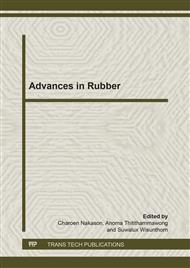p.395
p.399
p.406
p.410
p.417
p.421
p.425
p.429
p.433
Mesostructure Evolution during Storage of Rubber Films from Washed Cream Latex and Skim Latex
Abstract:
Fresh field latex (FL) of Hevea brasiliensis was centrifuged to separate the major compartments: (i) the cream, (ii) the skim plus the C-serum, and (iii) the bottom fraction. Cream was dispersed in distilled water to prepare cream washed latex or CL sample. Skim was collected together with C-serum to prepare the skim latex or SKL sample. Then, films were made from FL, CL and SKL. The mesostructure (macromolecular structure and aggregates or gel) of the natural rubber films was studied by size exclusion chromatography coupled to a multiangular light scattering detector (SEC-MALS). The mesostructure was analyzed on fresh films and on films stored in the laboratory for three months (slow structuring). This study showed that FL and CL films had bimodal elution profiles of long and short polyisoprene chains as revealed by the two peaks on the chromatograms at low and high elution volumes, respectively. On the contrary, SKL films exhibited unimodal elution profiles at low elution volume and a highly abnormal molar masses elution profiles. After 3 months storage, the mesostructure of FL evolved dramatically especially the number-average molar masses (Mn), which increased by 60%. The mesostructure of CL films evolved at a lesser extent and, the mesostructure of SKL films exhibited no significant change. These results indicated (i) the skim rubber particles are not prone to slow structuring during storage in presence of serum and (ii) some constituents either in the serum or/and in the bottom fraction could still be present with cream and be involved in the slow structuring of cream particles latex.
Info:
Periodical:
Pages:
417-420
Citation:
Online since:
November 2013
Keywords:
Price:
Сopyright:
© 2014 Trans Tech Publications Ltd. All Rights Reserved
Share:
Citation:


